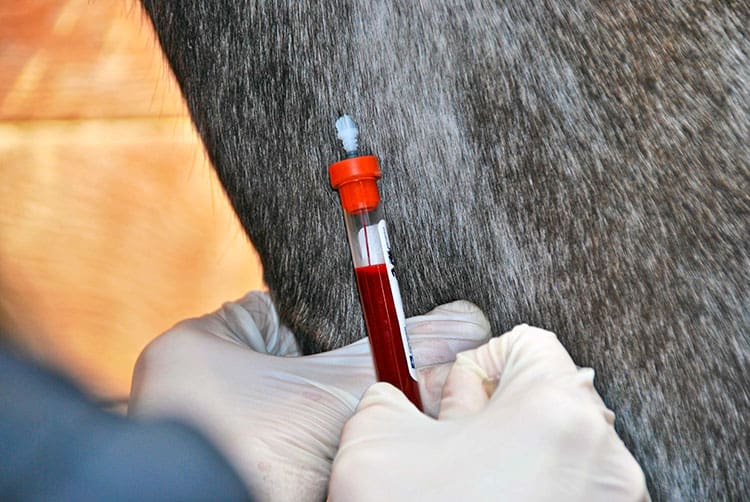Serum Chemistries Can Help Diagnose Racehorse Poor Performance

During the 2021 American Association of Equine Practitioners (AAEP) Convention, held Dec. 4-8 in Nashville, Tennessee, Thomas J. Divers, DVM, Dipl. ACVIM, ACVECC, Rudolph J. and Katharine L. Steffen Professor emeritus of Veterinary Medicine at Cornell University’s College of Veterinary Medicine, in Ithaca, New York, explained how veterinarians can use these tests to evaluate poor performance in horses.
Common Findings Indicative of Poor Performance
Blood, serum, and plasma can tell us a great deal about some horses’ decline in performance. The white blood cell count from a CBC, for instance, can reveal whether a horse is battling an inflammatory disease while increases in the muscle enzymes aspartate aminotransferase (AST) and creatine kinase (CK) can be indicative of muscle disease.
Other important substances to assess include gamma-glutamyl transferase (GGT), serum or plasma proteins, bilirubin, total carbon dioxide (CO2), creatinine concentrations, glutamate dehydrogenase (GLDH), and sorbitol dehydrogenase (SDH) activity. Divers reviewed some of these and what to look for during his presentation.
AST and CK The horse’s muscle enzymes are some of the most important performance-related chemistries to evaluate, he said. Marked increases in AST and CK activity in racehorses are most commonly due to recurrent exertional rhabdomyolysis (RER), a genetic muscle disorder found in 5-10% of Thoroughbreds and Standardbreds.
“If you have high muscle enzymes in the chemistry report and the clinical signs (stiffness, shortened stride, and painful muscles after racing) to go with it, then you can be fairly certain a myopathy is causing the poor performance on that day,” Divers said. If RER is the possible cause, consider implementing diet (TheHorse.com/184186) and training changes for these horses to reduce their risk of further muscle injury.
GGT Increased GGT (predominantly a liver enzyme) activity is another common abnormality in racehorses. Divers said it might be accompanied by clinical signs such as weight loss and fatigue in a small percentage of horses, but most horses appear perfectly normal.
Study results have shown increased GGT activity to be associated with cumulative racing and training days, with levels returning to normal when horses stop or decrease training. Therefore, researchers believe GGT increases might be caused by maladaptation to training and reducing a horse’s work can lower his levels. Scientists are also investigating medical treatments to decrease oxidative stress or improve bile flow.
If, in addition to GGT, other liver-specific enzymes have moderate to marked increased activity, Divers advised veterinarians to consider hepatic diseases such as viral hepatitis or a toxic hepatopathy. Mild increases in SDH are common in racehorses and likely of no clinical significance. Serum bilirubin concentration might be increased from hemolysis, anorexia, or liver dysfunction.
“Approximately 5% of healthy horses have serum bilirubin values above the laboratory reference range, so if the clinical exam and all other laboratory results are normal, the increased bilirubin in that horse should not be overinterpreted as a medical problem,” said Divers.
Serum proteins Abnormal levels of various serum proteins can point to underlying health issues. Horses with high serum proteins and globulins—particularly those that are underperforming and showing signs of weight loss—might have some form of chronic inflammation, such as a lung abscess, said Divers.
“Decreases in albumin and total protein generally indicate an intestinal disorder,” he added.
High serum amyloid A concentrations suggest acute inflammation. “Serum amyloid levels usually increase minimally or not at all after racing, and if they do go up slightly, they should be back to normal by Day 3,” he explained. “If they’re not back to normal by Day 3, you need start looking for an inflammatory disease,” such as an infection in the lungs or inflammation in other soft tissues.
Lactate and bicarbonate These values’ effects on racing performance are more difficult to interpret. Higher-than-expected lactate values immediately after racing or abnormally slow return to normal can point to performance-limiting health issues.
“High lactate values could result from cardiopulmonary disorders and increased anaerobic glycolysis,” said Divers. “Measuring blood lactate levels during treadmill exercise testing can be more helpful than a single sample taken after racing.”
Increases in bicarbonate are often associated with synchronous diaphragmatic flutter (“thumps,” the rhythmic contraction of the horse’s abdomen typically caused by electrolyte imbalances).
Take-Home Message
Serum chemistry analysis should be part of the diagnostic work-up on poorly performing horses when a thorough history and clinical exam, including on-site ultrasound or endoscopy, don’t reveal a cause.
“The most common abnormalities noted on chemistry analysis of poor performance horses are increased activity of muscle enzymes (CK and AST) and increased GGT activity,” said Divers.

Written by:
Alexandra Beckstett
Related Articles
Stay on top of the most recent Horse Health news with















